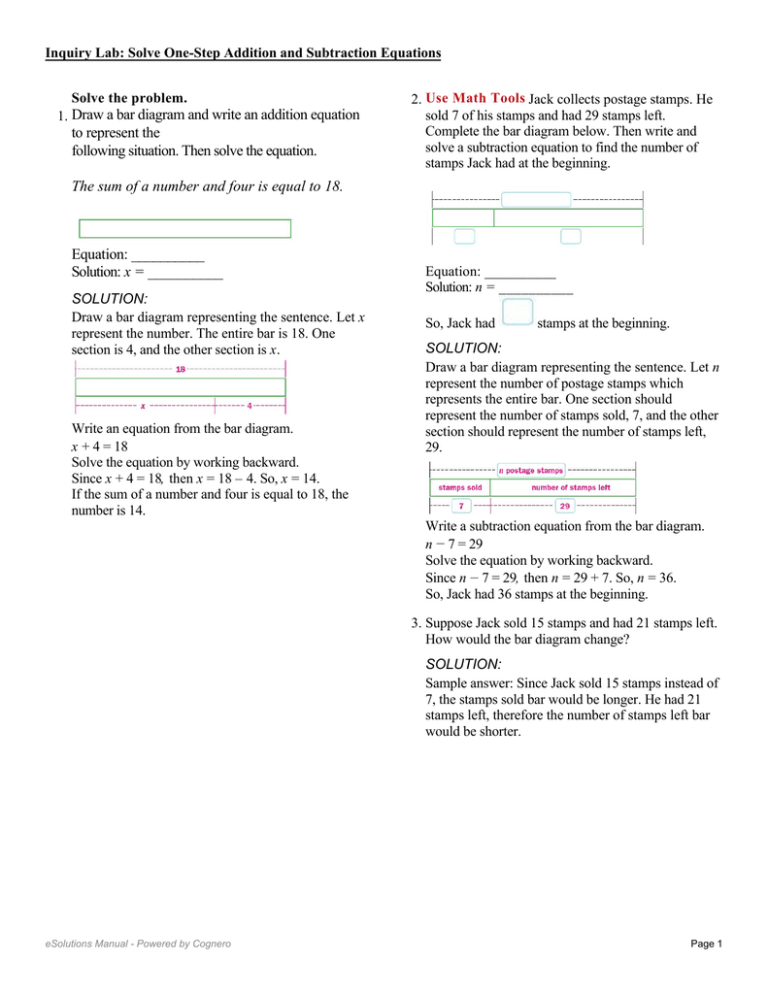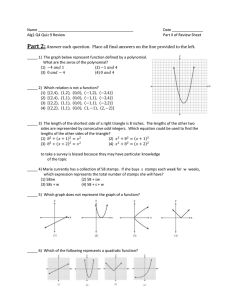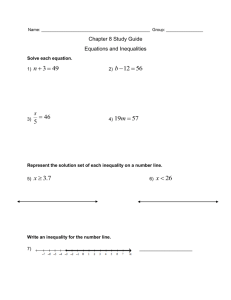1. Draw a bar diagram and write an addition equation to represent
advertisement

x + 4 = 18 Solve the equation by working backward. Since x + 4 = 18, then x = 18 – 4. So, x = 14. If the sum of a number and four is equal to 18, the Inquiry Lab: Solve One-Step Addition and Subtraction Equations number is 14. Solve the problem. 1. Draw a bar diagram and write an addition equation to represent the following situation. Then solve the equation. The sum of a number and four is equal to 18. Equation: __________ Solution: x = __________ SOLUTION: Draw a bar diagram representing the sentence. Let x represent the number. The entire bar is 18. One section is 4, and the other section is x. Write an equation from the bar diagram. x + 4 = 18 Solve the equation by working backward. Since x + 4 = 18, then x = 18 – 4. So, x = 14. If the sum of a number and four is equal to 18, the number is 14. 2. Use Math Tools Jack collects postage stamps. He sold 7 of his stamps and had 29 stamps left. Complete the bar diagram below. Then write and solve a subtraction equation to find the number of stamps Jack had at the beginning. Equation: __________ Solution: n = __________ So, Jack had stamps at the beginning. SOLUTION: Draw a bar diagram representing the sentence. Let n represent the number of postage stamps which represents the entire bar. One section should represent the number of stamps sold, 7, and the other section should represent the number of stamps left, 29. eSolutions Manual - Powered by Cognero Write a subtraction equation from the bar diagram. 2. Use Math Tools Jack collects postage stamps. He sold 7 of his stamps and had 29 stamps left. Complete the bar diagram below. Then write and solve a subtraction equation to find the number of stamps Jack had at the beginning. Equation: __________ Solution: n = __________ So, Jack had stamps at the beginning. SOLUTION: Draw a bar diagram representing the sentence. Let n represent the number of postage stamps which represents the entire bar. One section should represent the number of stamps sold, 7, and the other section should represent the number of stamps left, 29. Write a subtraction equation from the bar diagram. n – 7 = 29 Solve the equation by working backward. Since n – 7 = 29, then n = 29 + 7. So, n = 36. So, Jack had 36 stamps at the beginning. 3. Suppose Jack sold 15 stamps and had 21 stamps left. How would the bar diagram change? SOLUTION: Sample answer: Since Jack sold 15 stamps instead of 7, the stamps sold bar would be longer. He had 21 stamps left, therefore the number of stamps left bar would be shorter. 4. Reason Abstractly Suppose Jack had 40 stamps in the beginning and sold 7 of them. How would the bar diagram change? What equation could you write to represent the situation? SOLUTION: Sample answer: Draw a bar diagram representing the sentence. Label the entire bar diagram length as 40 since he had 40 stamps in the beginning. The number of stamps sold is still 7, so label the one section 7. The other section would represent the number of stamps Page 1 left, which is the unknown. Use n to represent the number of stamps left. Write an equation from the bar diagram. SOLUTION: Sample answer: Since Jack sold 15 stamps instead of There are no 1-tiles remaining on the right side of the 7, the stamps sold bar would be longer. He had 21 mat. stamps left, therefore the number of stamps left bar Inquiry Lab: Solve One-Step Addition and Subtraction Equations Therefore, x = 0. would be shorter. 4. Reason Abstractly Suppose Jack had 40 stamps in the beginning and sold 7 of them. How would the bar diagram change? What equation could you write to represent the situation? SOLUTION: Sample answer: Draw a bar diagram representing the sentence. Label the entire bar diagram length as 40 since he had 40 stamps in the beginning. The number of stamps sold is still 7, so label the one section 7. The other section would represent the number of stamps left, which is the unknown. Use n to represent the number of stamps left. Write an equation from the bar diagram. 7 + n = 40 6. –2 = x + 1 x = _____ SOLUTION: Model the equation. Place two −1-tiles on the left side of the mat. Place one x-tile and one 1-tile on the right side of the mat. Add one −1-tile to the left side of the mat and add one −1-tile to the right side of the mat to form a zero pair on the right. Use Math Tools Solve the equation. Use algebra tiles. Show your work using drawings. 5. x + 4 = 4 x = _____ Remove the zero pair from the right side. There are three −1-tiles on the left side of the mat. Therefore, x = –3. 7. x – 1 = –3 x = _____ SOLUTION: Model the equation. Place one x-tile and four 1-tiles on the left side of the mat. Place four 1-tiles on the right side of the mat. Remove four 1-tiles from each side of the mat so that the variable is by itself on the left side. There are no 1-tiles remaining on the right side of the mat. Therefore, x = 0. SOLUTION: Model the equation. Place one x-tile and one −1-tile on the left side of the mat. Place three −1-tiles on the right side of the mat. Add one 1-tile to the left side of the mat and add one 1-tile to the right side of the mat to form a zero pair on the left. Identify the zero pair that is formed on the right side of the mat. 6. –2 = x + 1 x = _____ eSolutions Manual - Powered by Cognero Remove the zero pair from each side. There arePage two 2 −1-tiles on the right side of the mat. Therefore, x = –2. Remove the zero pair from the right side. There are Remove the zero pair from each side. There are two threeLab: on One-Step the left sideAddition of the mat. Inquiry Solve and Subtraction Equations −1-tiles on the right side of the mat. −1-tiles Therefore, x = –3. Therefore, x = –2. 7. x – 1 = –3 x = _____ 8. 4 = x – 2 x = _____ SOLUTION: Model the equation. Place one x-tile and one −1-tile on the left side of the mat. Place three −1-tiles on the right side of the mat. Add one 1-tile to the left side of the mat and add one 1-tile to the right side of the mat to form a zero pair on the left. Identify the zero pair that is formed on the right side of the mat. SOLUTION: Model the equation. Place four 1-tiles on the left side of the mat. Place one x-tile and two −1-tiles on the right side of the mat. Add two 1-tiles to the right side of the mat and add two 1-tiles to the left side of the mat to form zero pairs on the right. Remove the zero pair from each side. There are two −1-tiles on the right side of the mat. Therefore, x = –2. Remove the zero pairs from the right side. There are six 1-tiles on the left side of the mat. Therefore, x = 6. Complete the table. The first one is done for you. 8. 4 = x – 2 x = _____ 9. SOLUTION: Model the equation. Place four 1-tiles on the left side of the mat. Place one x-tile and two −1-tiles on the right side of the mat. Add two 1-tiles to the right side of the mat and add two 1-tiles to the left side of the mat to form zero pairs on the right. SOLUTION: To solve an equation like 6 + x = 10, you “undo” the last operation that was applied to the variable and continue to “undo” operations in reverse order until the value of the unknown is determined. In the case of 6 + x = 10, the last operation applied to the variable x is adding 6. To undo adding 6, you would subtract 6 from each side. So, in general, if a number is added to the variable, subtract that number from both sides of the equation. So, the related equation would be x = 10 – 6. eSolutions Manual - Powered by Cognero Remove the zero pairs from the right side. There are six 1-tiles on the left side of the mat. Therefore, x = 6. Page 3 Remove the zero pairs from the right side. There are six 1-tiles the One-Step left side ofAddition the mat. and Subtraction Equations Inquiry Lab: on Solve Therefore, x = 6. Complete the table. The first one is done for you. 10. 9. SOLUTION: To solve an equation like x + 3 = –1, you “undo” the last operation that was applied to the variable and continue to “undo” operations in reverse order until the value of the unknown is determined. In the case of x + 3 = –1, the last operation applied to the variable x is adding 3. To undo adding 3, you would subtract 3 from each side. So, in general, if a number is added to the variable, subtract that number from both sides of the equation. So, the related equation would be x = –1 – 3. SOLUTION: To solve an equation like 6 + x = 10, you “undo” the last operation that was applied to the variable and continue to “undo” operations in reverse order until the value of the unknown is determined. In the case of 6 + x = 10, the last operation applied to the variable x is adding 6. To undo adding 6, you would subtract 6 from each side. So, in general, if a number is added to the variable, subtract that number from both sides of the equation. So, the related equation would be x = 10 – 6. 11. 10. SOLUTION: To solve an equation like x + 3 = –1, you “undo” the last operation that was applied to the variable and continue to “undo” operations in reverse order until the value of the unknown is determined. In the case of x + 3 = –1, the last operation applied to the variable x is adding 3. To undo adding 3, you would subtract 3 from each side. So, in general, if a number is added to the variable, subtract that number from both sides of the equation. So, the related equation would be x = –1 – 3. eSolutions Manual - Powered by Cognero SOLUTION: To solve an equation like 6 + x = –7, you “undo” the last operation that was applied to the variable and continue to “undo” operations in reverse order until the value of the unknown is determined. In the case of 6 + x = –7, the last operation applied to the variable x is adding 6. To undo adding 6, you would subtract 6 from each side. So, in general, if a number is added to the variable, subtract that number from both sides of the equation. So, the related equation would be x = –7 – 6. 12. Construct an Argument Write a rule that you can use to solve addition equations without using models Page 4 or a drawing. SOLUTION: Inquiry Lab: Solve One-Step Addition and Subtraction Equations 12. Construct an Argument Write a rule that you can use to solve addition equations without using models or a drawing. SOLUTION: To solve an equation like x + 3 = 2, you “undo” the last operation that was applied to the variable and continue to “undo” operations in reverse order until the value of the unknown is determined. In the case of x + 3 = 2, the last operation applied to the variable x is adding 3. To undo adding 3, you would subtract 3 from each side. So, in general, if a number is added to the variable, subtract that number from both sides of the equation. 13. HOW can bar diagrams or algebra tiles help you solve an equation? SOLUTION: Sample answer: A bar diagram or an algebra tile model provides a visual aid when deciding which operation to use. eSolutions Manual - Powered by Cognero Page 5



